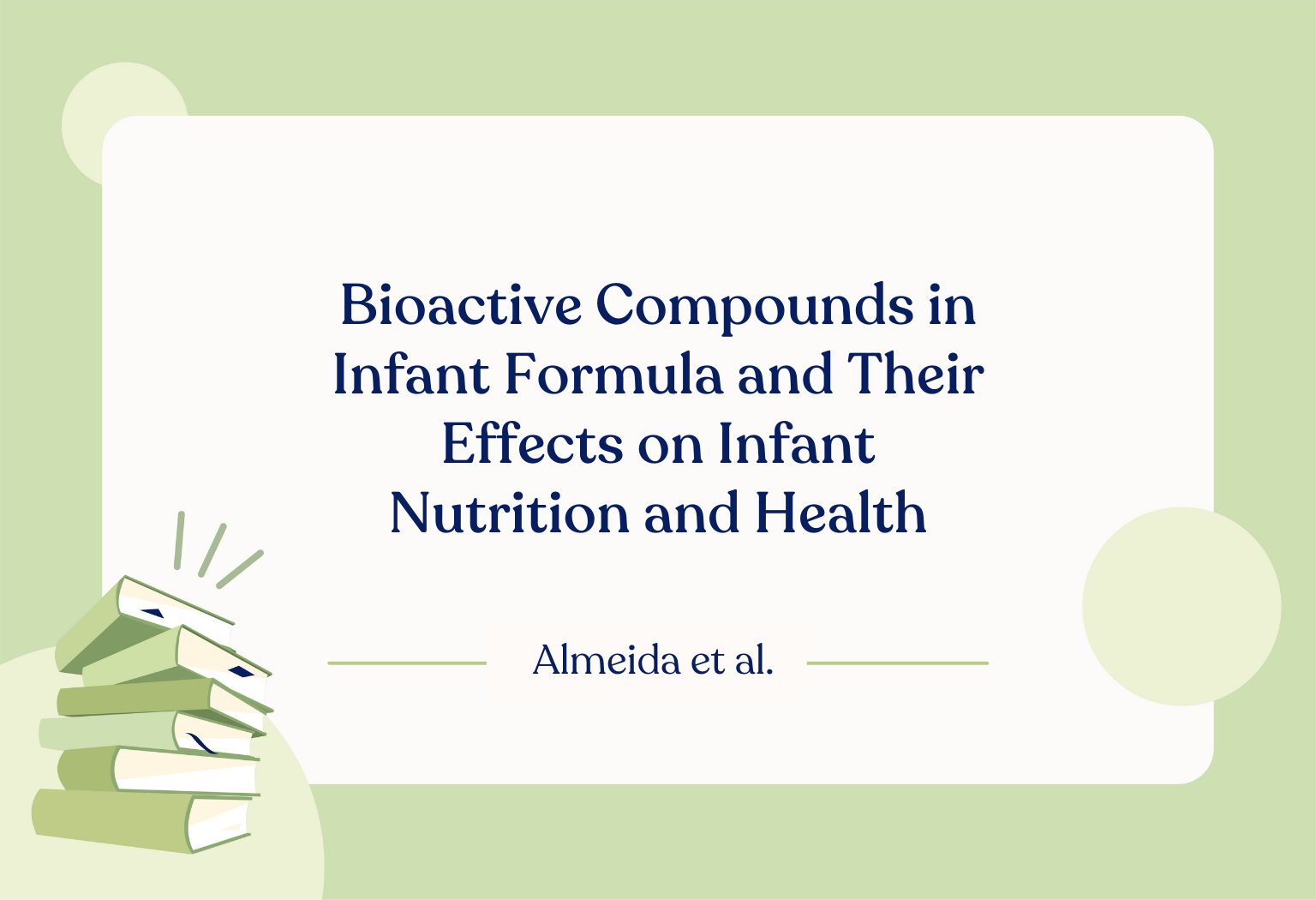References
- Fanzo J, Hawkes C, Udomkesmalee E, Afshin A, Allemandi L, Assery O, Baker P, Battersby J, Bhutta Z, Chen K, Corvalan C. 2018 Global Nutrition Report: Shining a light to spur action on nutrition.
- Hebert EM, Saavedra L, Ferranti P. Bioactive peptides derived from casein and whey proteins. Biotechnology of lactic acid bacteria: Novel applications. 2010 Jan 29:233-49.
- Hernandez-Ledesma B, Quiros A, Amigo L, Recio I. Identification of bioactive peptides after digestion of human milk and infant formula with pepsin and pancreatin. International Dairy Journal. 2007 Jan 1;17(1):42-9.
- Enjapoori AK, Kukuljan S, Dwyer KM, Sharp JA. In vivo endogenous proteolysis yielding beta-casein derived bioactive beta-casomorphin peptides in human breast milk for infant nutrition. Nutrition. 2019 Jan 1;57:259-67.
- Wada Y, Loennerdal B. Bioactive peptides derived from human milk proteins—mechanisms of action. The Journal of nutritional biochemistry. 2014 May 1;25(5):503-14.
- Telang S. Lactoferrin: a critical player in neonatal host defense. Nutrients. 2018 Sep 4;10(9):1228.
- Aly E, Ros G, Frontela C. Structure and functions of lactoferrin as ingredient in infant formulas. Journal of Food Research. 2013 Aug 1;2(4):25.
- Nguyen TT, Bhandari B, Cichero J, Prakash S. A comprehensive review on in vitro digestion of infant formula. Food Research International. 2015 Oct 1;76:373-86.
- Kilb W, Fukuda A. Taurine as an essential neuromodulator during perinatal cortical development. Frontiers in cellular neuroscience. 2017 Oct 24;11:328.
- Verner AM, McGuire W, Craig JS. Effect of taurine supplementation on growth and development in preterm or low birth weight infants. Cochrane Database of Systematic Reviews. 2007(4).
- Black MM. Effects of vitamin B12 and folate deficiency on brain development in children. Food and nutrition bulletin. 2008 Jun;29(2_suppl1):S126-31.
- Bjelakovic L, Kocic G, Bjelakovic B, Najman S, Stojanović D, Jonovic M, Pop-Trajkovic Z. Polyamine oxidase and diamine oxidase activities in human milk during the first month of lactation. Iranian Journal of Pediatrics. 2012 Jun;22(2):218.
- Timby N, Domellöf E, Hernell O, Lönnerdal B, Domellöf M. Neurodevelopment, nutrition, and growth until 12 mo of age in infants fed a low-energy, low-protein formula supplemented with bovine milk fat globule membranes: a randomized controlled trial. The American journal of clinical nutrition. 2014 Apr 1;99(4):860-8.
- Gurnida DA, Rowan AM, Idjradinata P, Muchtadi D, Sekarwana N. Association of complex lipids containing gangliosides with cognitive development of 6-month-old infants. Early human development. 2012 Aug 1;88(8):595-601.
- Tinoco SM, Sichieri R, Moura AS, Santos FD, Carmo MD. The importance of essential fatty acids and the effect of trans fatty acids in human milk on fetal and neonatal development. Cadernos de saude publica. 2007;23:525-34.
- Innis SM, Gilley J, Werker J. Are human milk long-chain polyunsaturated fatty acids related to visual and neural development in breast-fed term infants?. The Journal of pediatrics. 2001 Oct 1;139(4):532-8.
- Lien EL, Richard C, Hoffman DR. DHA and ARA addition to infant formula: Current status and future research directions. Prostaglandins, Leukotrienes and Essential Fatty Acids. 2018 Jan 1;128:26-40.
- Closa-Monasterolo R, Gispert-Llaurado M, Luque V, Ferre N, Rubio-Torrents C, Zaragoza-Jordana M, Escribano J. Safety and efficacy of inulin and oligofructose supplementation in infant formula: results from a randomized clinical trial. Clinical Nutrition. 2013 Dec 1;32(6):918-27.
- Braegger C, Chmielewska A, Decsi T, Kolacek S, Mihatsch W, Moreno L, Piescik M, Puntis J, Shamir R, Szajewska H, Turck D. Supplementation of infant formula with probiotics and/or prebiotics: a systematic review and comment by the ESPGHAN committee on nutrition. Journal of pediatric gastroenterology and nutrition. 2011 Feb 1;52(2):238-50.

